This article appeared originally in The Washington Post.
As intros to backpacking go, this might be pushing it. At noon on a brilliant Tuesday in March, my 12-year-old son Kai and I are a mile and a half into a four-day, 27-mile walk through the Grand Canyon — his first backpacking trip — when he asks: “Are we almost to camp?”
Um, no. Camp, at Hermit Creek, is seven miles and nearly 2,500 vertical feet below, a trek that will take us several more hours. We’re descending the Hermit Trail, a poorly maintained path off the canyon’s South Rim, and have paused on a precipice, across which we can see many of the canyon’s neatly stacked layers: the chalky beiges and browns of the upper Kaibab, Toroweap and Coconino formations, which yield to the pinkish pastels of the Hermit, Supai and Redwall deposits below. This is on display in cliffs hundreds of feet tall, a stark reminder of how far we have to go — and how quickly we could get there with one misstep.
We are here largely because of a birthday note Kai wrote me two years ago in which he declared, “You used to be a wild 10-year-old like me and now you’re a wild 53-year-old. I love you so much and never want to leave you. But until then we can do so many things together! I am practically squirming in my seat thinking about when I’m old enough for the Grand Canyon!”
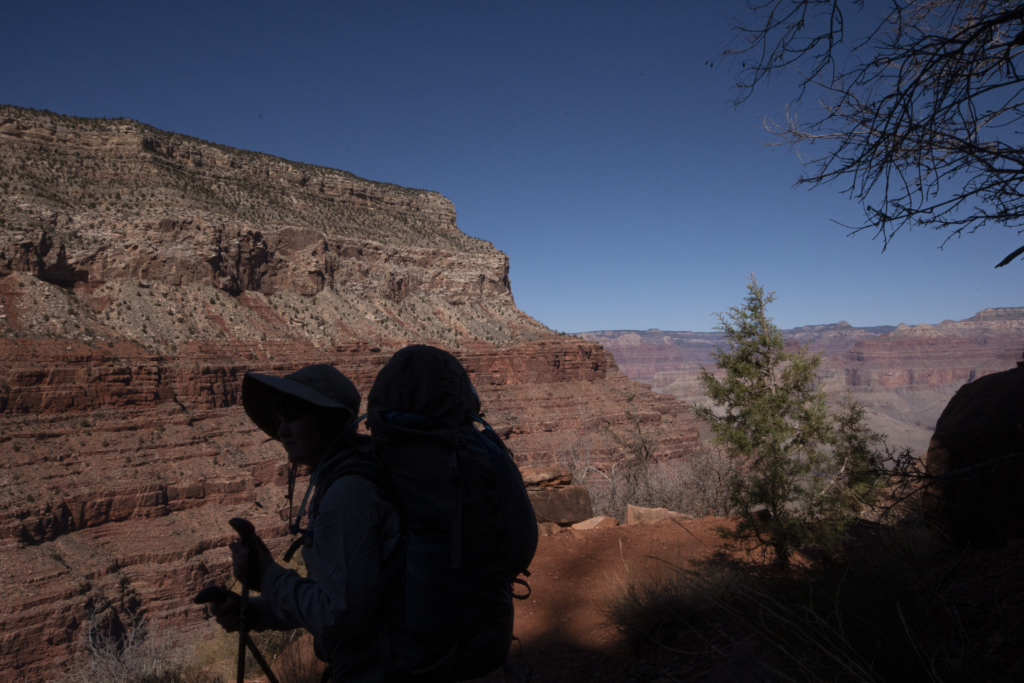
There are, I suppose, dads who could resist that, just as there are fathers who would plan an experience-appropriate trip for their sons. I am neither, so here we are. Never mind that, aside from simply being 12, Kai has done almost nothing to physically prepare for this. Or that I haven’t backpacked in 13 years. Or that my badly dated gear is far heavier than what most people carry these days. The exception: our hiking boots, which we bought a week ago and “broke in” in a stroll around our neighborhood the day before we flew out here.
All of this might be fine in a place where car, cell reception and emergency help are within reasonable reach. But in the Grand Canyon, the slightest mishap — sprained ankle, dehydration, gastrointestinal ailment, broken water filter — can become a code red emergency, and it might even prove fatal because help, if you can summon it at all, could take many hours to arrive.
Although I spend my share of time adventuring, and don’t sincerely believe I’m leading Kai to his doom, I’m still far more anxious than I’d be if I was flying solo here. This wouldn’t be the case had I secured a permit to camp solely along the Grand Canyon’s heavily trafficked main corridor trails, which feature ranger stations, emergency phones and at least occasional sources of potable water (though even those trails are daunting).
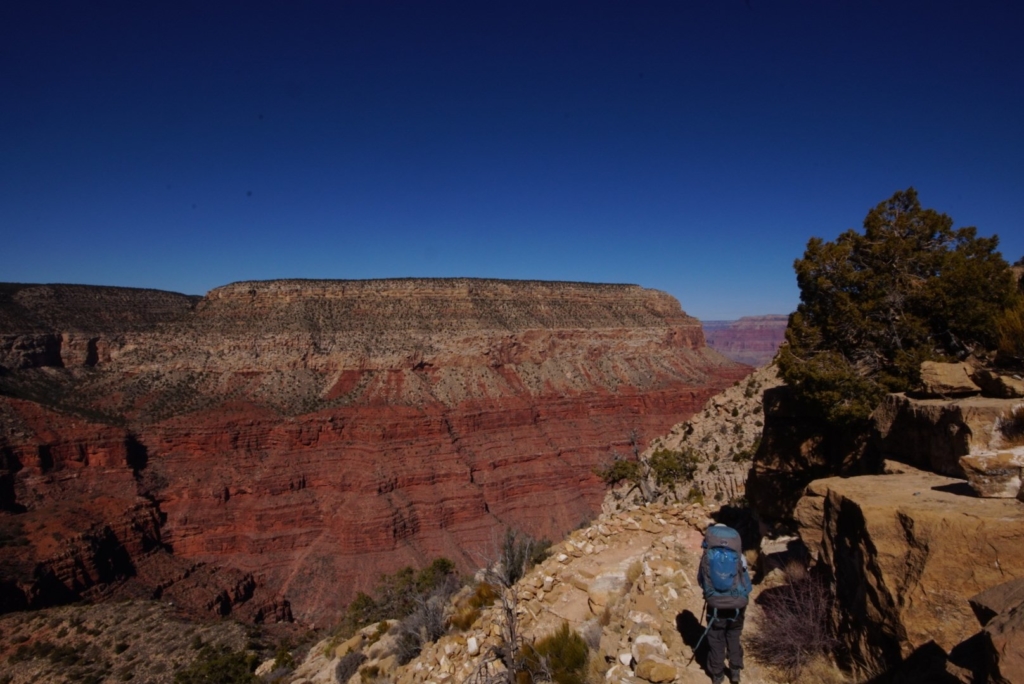
Instead we have two nights in what the national park calls threshold campsites, with pit toilets (BYO TP) and no other amenities, before a final night in the corridor. We’re carrying all our food (mostly dehydrated meals) and will have to filter our drinking water, but at least we’re camping near reliable streams. And, while backpacking poses a low risk of coronavirus transmission, we have masks at the ready for anyone we meet on the trail, and we double-masked throughout our travel here.
We head on past low, twisty juniper and pinyon trees and clumps of sagebrush clinging to the severe terrain. Soon the view broadens to the North Rim, and the stack grows deeper, down to the shadowy, 1.8 billion-year-old Vishnu, a panorama that leaves Kai spellbound. “This place is amazing,” he says, before inquiring again about the time left before he can cast off his pack. He has never even put on a backpack before; I rented him this one en route in Flagstaff, Ariz., at the same store where I bought his oversized hiking pants. That, coupled with the sun shirt and brimmed hat he borrowed from my wife, lends him a likeness to Paddington Bear, out on a grand adventure.
Oddly, a century ago we would have had an easier go of it. The Hermit Trail was once a supremely maintained path that guided groups traveling on muleback to and from a luxury camp at Hermit Creek. The trail and camp were built in 1911 by the Fred Harvey Co., the hospitality division of the Santa Fe Railway, as an alternative to the Bright Angel Trail, which was controlled as a concession by the businessman — and eventual U.S. senator — Ralph Cameron.
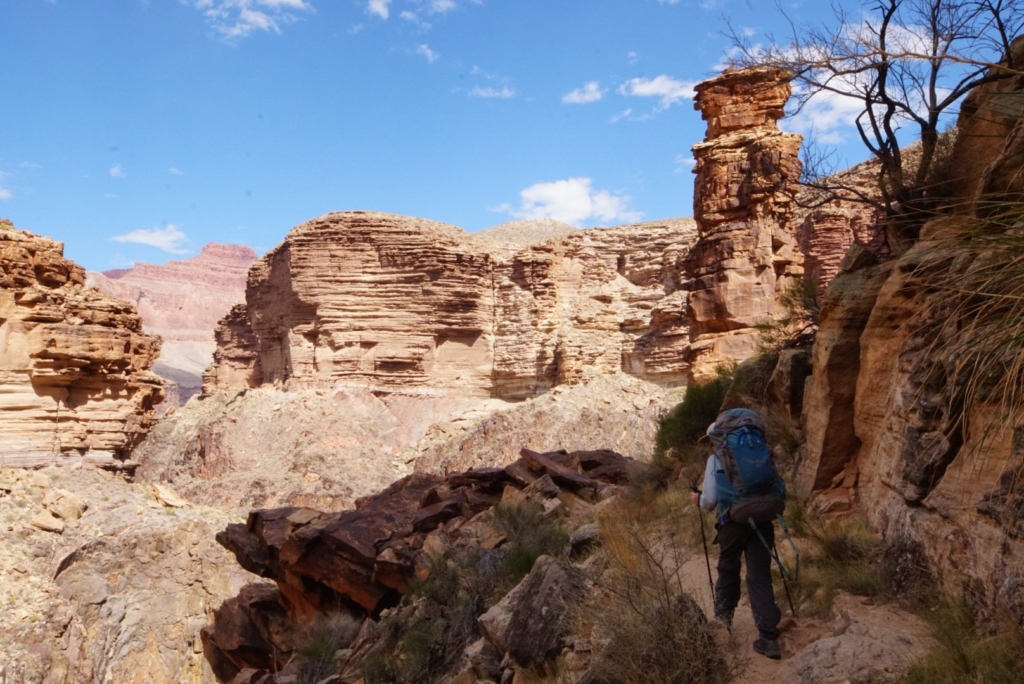
A set of steep, scree-strewn switchbacks ejects us onto the Tonto Platform, a sloping shelf of sage-hued shale festooned with prickly pear and barrel cactus, blackbrush and spindly yucca. From here, we will head a couple of miles downriver to Hermit Creek, then buttonhook upriver to camp one night each in Monument Creek and Indian Creek before hiking out the Bright Angel Trail on Friday.
We arrive in Hermit dusty, beat and famished — where have you gone, Fred Harvey? — but with no injuries, blisters or other serious concerns. We find a site among the half-dozen or so etched into a steep embankment above the creek, with ample space between us and the two other parties here, a solo guy and two women.
Nightfall in the canyon, depending on your mood, can be magical or ominous. Darkness pours into every crevice, pressed by chilling air, and tiny sounds assume deep backstories. We navigate a narrow path to the creek and, lulled by the sound of a waterfall, lie back on a boulder to take in the stars. Twice I suggest we turn in. “Not yet,” Kai says. “This is too unbelievable.”
The Wednesday plan is to knock out the 3½ easy miles to Monument Creek, drop our packs and hike a mile — and 1,000 vertical feet — down to the Colorado River. And we reach Monument by 1 p.m., well in time for the river hike. But as I’m unloading gear I glance up to see that my boy has fallen asleep, standing up, while leaning against a sun-baked rock. I backslide into a pit of guilt, and begin to worry deeply about our 11-mile day tomorrow.
Later, we are chatting with a trio of 50-something hikers from Flagstaff, when one of them interrupts herself: “Just so you know: There’s a bighorn sheep walking across the cliff right behind you.”
Indeed there is — muscular, agile, with those flamboyant, comma-shaped horns. Once it reaches the far side of camp, it lies down and stares back from where it came. Kai is rapt, prodding me to take more photos and reporting on the animal’s every move as I make dinner.
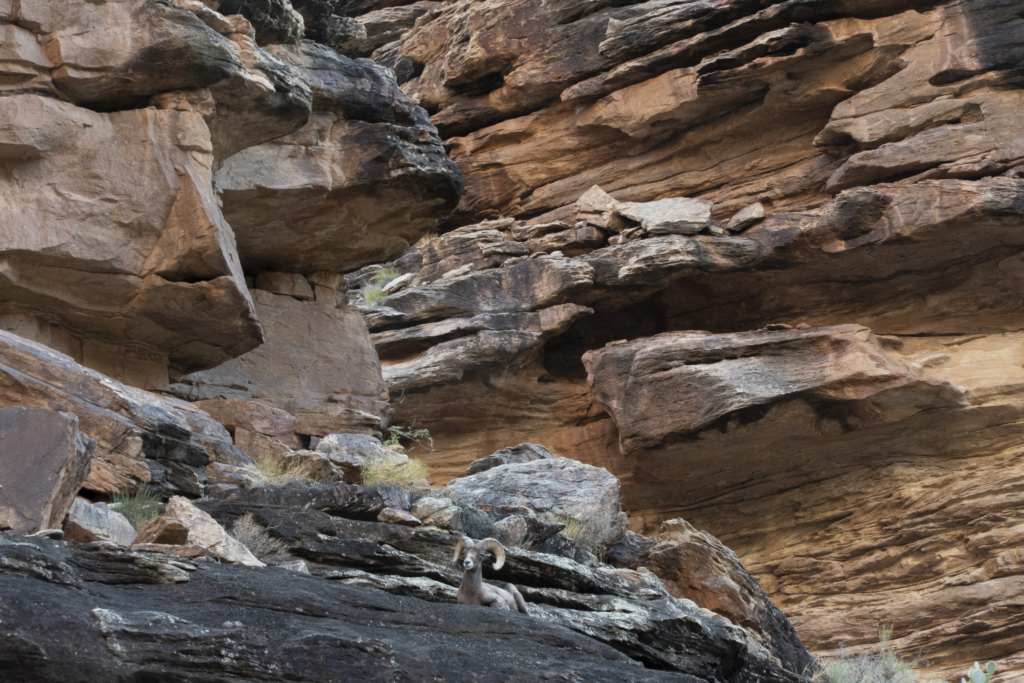
We also meet two solo campers at Monument Creek, a guy named George VanMeter who posts videos of his backpacking trips on his YouTube channel, GeorgeBackpacking, and an Oregonian named Jo Zacher, who is nearing the end of a 50-day hike. “It gives you more time to stare at nature,” she explains. Like most long-haul Grand Canyoneers, Zacher had cached food — in sealed, labeled plastic bins, to dissuade theft by wildlife or humans — at strategic points along her route. She had also endured many bitter, snowy nights, and her melancholic tone suggests she is ready to go home.
That night, the wind ramps up, and rain peppers the tent in bursts. I sleep maybe four hours and awaken with fresh worries: Will it rain all day? Can we filter enough water for an 11-mile trudge? (Of the two streams between camps, one is too silty to drink and the other, at Horn Creek, is radioactive because of uranium deposits in the hills above. “Drink here only if your only other option is death by thirst,” our permit says.) And: Is this the day Kai cracks and folds?
But when we march out of Monument Creek at 7:30 a.m., with cool mist billowing down from the rim, I’m optimistic. Kai sets a brisk pace as the trail lurches up from the wash, then levels for the long haul.
For most of the next few hours we feel like we are walking in place. The Tonto wends into a huge, red-walled embayment, called the Inferno, and our view — while stirring — holds distressingly steady. At one point Kai spots the Flagstaffers, who had left camp 30 minutes ahead of us, on the other side of the drainage, well within shouting distance. “Hey, Dad, they’re right there! We’ll catch them soon.”
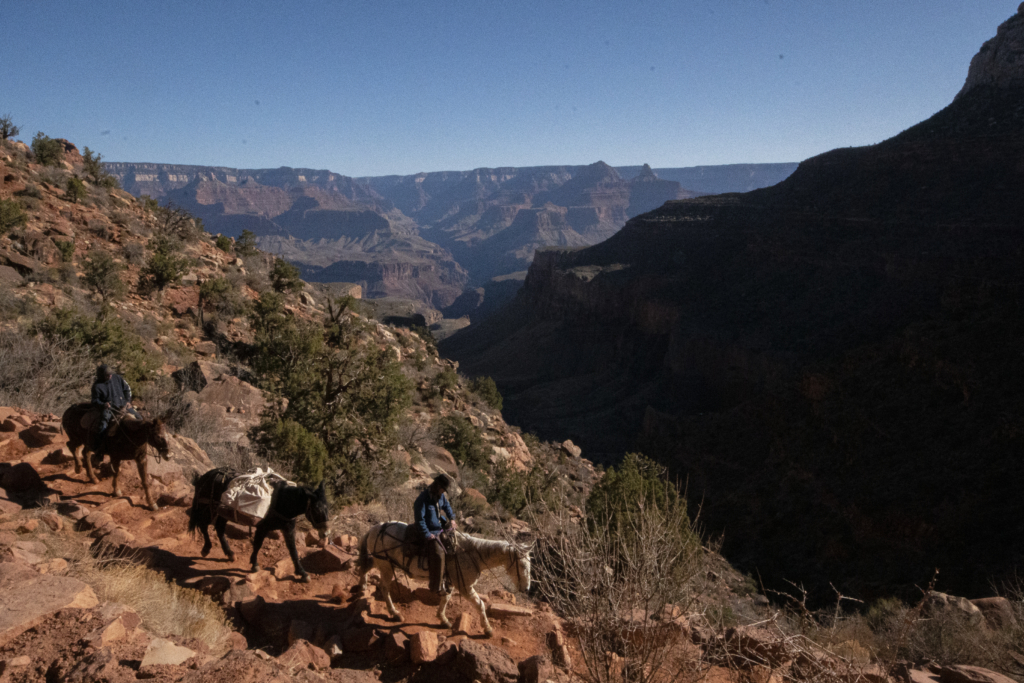
But when we round the next bend it becomes clear just how far the trail goes before doubling back toward the river. Alas, they are at least an hour ahead.
By noon, the clouds have vanished, the temperature has settled in the high 50s, and we have wrestled free of the Inferno. At many points we can see — and often hear — the river, a vein of quenching green sluicing far below. Vantages into the inner gorge show clusters of sharp spires hewed from the dark Vishnu rock. But it’s still a long day. As we trundle along, Indian Garden rises in my imagination, an oasis pulsing with taco trucks and margarita bars, live music and happy mules ready to shuttle our packs up to the South Rim.
Kai breaks my reverie. “What are those ropes?” I’m convinced he’s hallucinating, but then I see them, too, telephone lines looping from the rim toward the corridor trails.
Even without taco trucks, Indian Garden is another dimension: mule stables, squared-off campsites with picnic tables, shelters and wildlife-proof food boxes, water spigots and the ranger station, all tucked in a grove of green-leafed cottonwood trees. George and the Flagstaff crew are there, as are at least five other parties, and my second emotion, after deep relief, is of overcrowding.
Friday we rise before dawn and are the first ones out of camp; for an hour we have the Bright Angel Trail and its soaring scenery to ourselves.
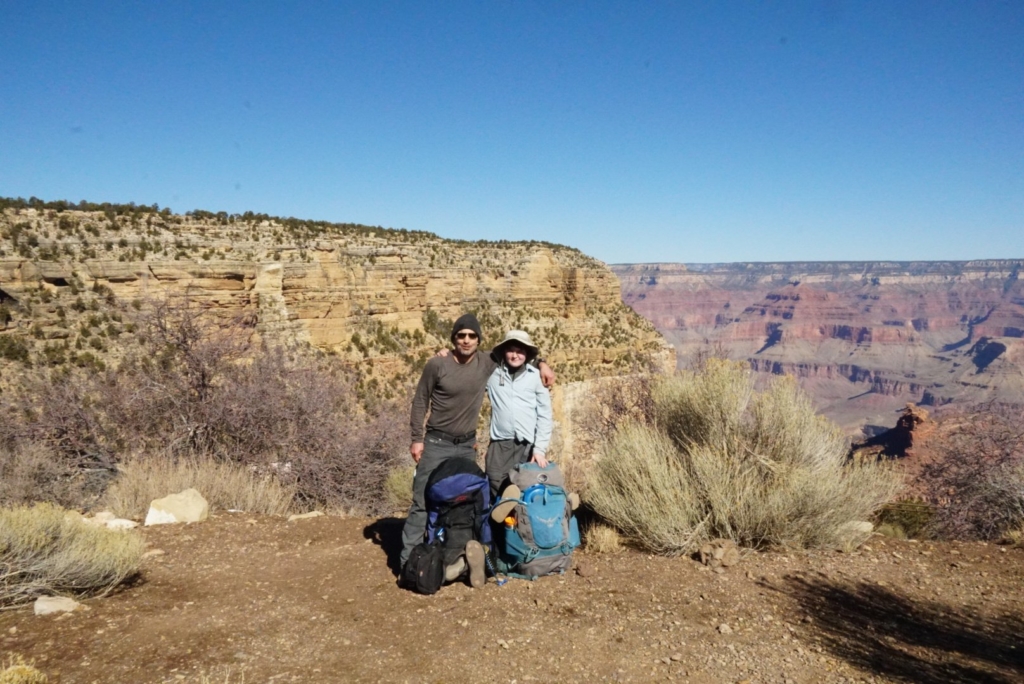
A third of the way into our five-mile, 3,100-vertical-foot ascent, George breezes past us. A dad on Day Four cannot compete with a budding YouTuber. Kai finds another gear, shadowing George and firing off questions as we rise through the layers, past descending mule trains and day hikers, over stretches of snow and ice, and finally onto the level ground of the South Rim. In that birthday card Kai had also written, “Even when you’re 100 you will always be wild.” Nice. If I’m lucky enough to make it there, it looks like I’ll have company.
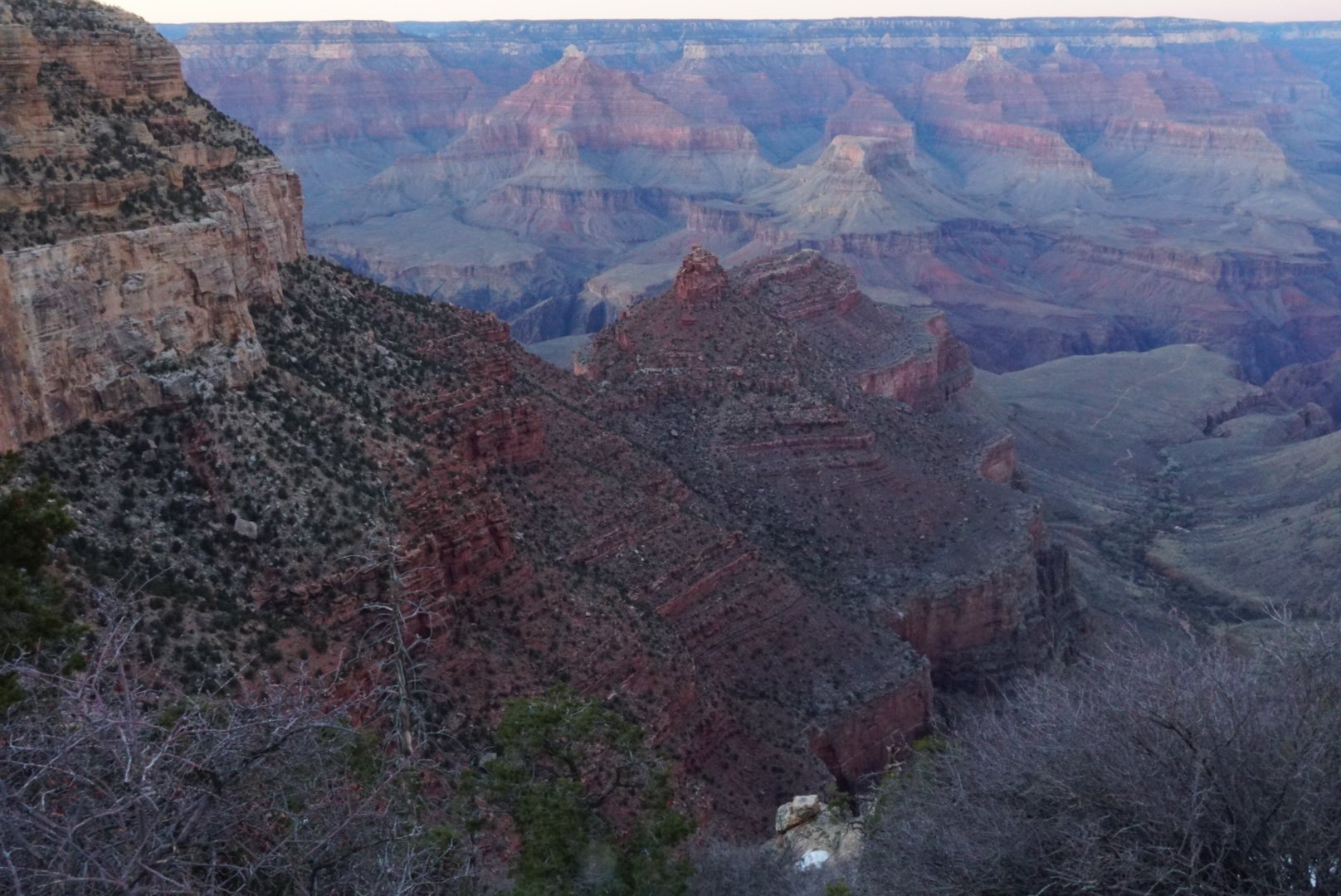
Beautiful story
My husband & I took our girls down to the bottom of the Grand Canyon when they were 12. We did the main trails (Kaibab down, Bright Angel up), and stayed at Phantom Ranch for a couple of days before hiking out. It was an incredible experience for all of us. It got really hot in very early April (over 90 degrees), which made it harder, but still a joy and challenge.
The hardest part was the elevation at the end of the trail when we were getting closer to the top. One of my girls really struggled and her dad had to carry her pack.
There are always times that you wonder if you did the right thing in bringing your kid down there, but we were really careful with water and food, and it was worth every step we took.
Thanks for the article, it reminded me of our trip, 7 years ago.
My husband & I took our girls down to the bottom of the Grand Canyon when they were 12. We did the main trails (Kaibab down, Bright Angel up), and stayed at Phantom Ranch for a couple of days before hiking out. It was an incredible experience for all of us. It got really hot in very early April (over 90 degrees), which made it harder, but still a joy and challenge.
The hardest part was the elevation at the end of the trail when we were getting closer to the top. One of my girls really struggled and her dad had to carry her pack.
There are always times that you wonder if you did the right thing in bringing your kid down there, but we were really careful with water and food, and it was worth every step we took.
Thanks for the article, it reminded me of our trip, 7 years ago.
You brought back so many memories of my 10 year old and I doing the phantom ranch trip in 2011and again as our last prepandemic trip in 2020. Both times we scored Phantom ranch the morning we were driving over and staying in Kingman az. So each trip started late lunchtime. Our joke the first time was, “next time you’ll carry the pack!” Well 9 years later he did and my 65 year old body greatly appreciated it!Great story and pictures. Thanks!!!
Have to try the hermit trial next time!
I absolutely loved reading about your adventure with your amazing son! You are an awesome dad.